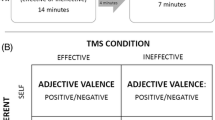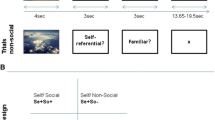Abstract
The processing of self-referential material is supposed to be located in the medial prefrontal cortex (MPFC) and in particular in the ventro-medial prefrontal cortex (VMPFC). A reliable method to assess effects of self-relevance is the so-called matching paradigm in which the prioritization of newly learned self-associations in comparison to non-self-relevant associations can be measured. To assess the connection of activation in the VMPFC and self-referential processing, we measured the self-prioritization effect (SPE) before and after experimentally manipulating activation in the VMPFC. We applied either excitatory or inhibitory stimulation to the VMPFC via transcranial direct current stimulation (tDCS). In a sample of N = 65 healthy adults, we found a significant SPE before and after both types of stimulation and, remarkably, no systematic change of the SPE due to the stimulation. These results are evidential against a direct dependence of the SPE from activation in the VMPFC, indicating either that the SPE differs from other, more elaborate self-effects, and thereby is processed in different brain areas, or that the connection of SPE and VMPFC is correlational rather than causal.


Similar content being viewed by others
Notes
Note that the corresponding analysis in the overall MANOVA indicated that the mean RTs in the two non-self-relevant conditions (i.e., with the label “friend” and with the label “chair”) did not differ significantly, F(1, 63) = 1.26, p = 0.267 (second Helmert contrast of the factor ‘shape association’), suggesting no performance differences between these two conditions.
References
Ambrus GG, Paulus W, Antal A (2010) Cutaneous perception thresholds of electrical stimulation methods: comparison of tDCS and tRNS. Clin Neurophysiol 121:1908–1914. https://doi.org/10.1016/j.clinph.2010.04.020
Chatrian G-E, Lettich E, Nelson PL (1988) Modified nomenclature for the “10%”electrode system. J Clin Neurophysiol 5:183–186. https://doi.org/10.1097/00004691-198804000-00005
Cohen J (1988) Statistical power analysis for the behavioral sciences, 2nd ed. Lawrence Erlbaum Associates, Hillsdale
Cunningham SJ, Turk DJ, Macdonald LM, Macrae CN (2008) Yours or mine? Ownership and memory. Conscious Cogn 17:312–318. https://doi.org/10.1016/j.concog.2007.04.003
Denny BT, Kober H, Wagner TD, Ochsner KN (2012) A meta-analysis of functional neuroimaging studies of self- and other judgments reveals a spatial gradient for mentalizing in medial prefrontal cortex. J Cogn Neurosci 24:1742–1752. https://doi.org/10.1162/jocn_a_00233
Faul F, Erdfelder E, Lang A, Buchner A (2007) GPower 3: A flexible statistical power analysis program for the social, behavioral and biomedical sciences. Behav Res Methods 39:175–191
Friehs MA, Frings C (2018) Pimping inhibition: anodal tDCS enhances stop-signal reaction time. J Exp Psychol Hum Percept Perform. https://doi.org/10.1037/xhp0000579
Frings C, Wentura D (2014) Self-prioritization processes in action and perception. J Exp Psychol Hum Percept Perform 40:1737–1740. https://doi.org/10.1037/a0037376
Frings C, Brinkmann T, Friehs MA, van Lipzig T (2018) Single session tDCS over the left DLPFC disrupts interference processing. Brain Cogn 120:1–7. https://doi.org/10.1016/j.bandc.2017.11.005
Fuentes LJ, Sui J, Estévez AF, Humphreys GW (2015) The differential outcomes procedure can overcome self-bias in perceptual matching. Psychon Bull Rev 23:451–458. https://doi.org/10.3758/s13423-015-0895-3
Gusnard DA, Akbudak E, Shulman GL, Raichle ME (2001) Medial prefrontal cortex and self-referential mental activity: relation to a default mode of brain function. Proc Nat Acad Sci 98:4259–4264. https://doi.org/10.1073/pnas.071043098
Hautus MJ (1995) Corrections for extreme proportions and their biasing effects on estimated values of d’. Behav Res Methods Instrum Comput 27:46–51. https://doi.org/10.3758/BF03203619
Humphreys GW, Sui J (2016) Attentional control and the self: the self-attention network (SAN). Cogn Neurosci 7:5–17. https://doi.org/10.1080/17588928.2015.1044427
Janczyk M, Humphreys GW, Sui J (2018) The central locus of self-prioritization. Q J Exp Psychol. https://doi.org/10.1177/1747021818778970
Jeffreys H (1961) Theory of probability. Oxford University Press, Oxford
Jenkins AC, Mitchell JP (2011) Medial prefrontal cortex subserves diverse forms of self-reflection. Soc Neurosci 3:211–218. https://doi.org/10.1080/17470919.2010.507948
Jeon SY, Han SJ (2012) Improvement of the working memory and naming by transcranial direct current stimulation. Ann Rehabil Med 36:585–595. https://doi.org/10.5535/arm.2012.36.5.585
Lieberman MD (2007) Social cognitive neuroscience: a review of core processes. Ann Rev Psychol 58:259–289. https://doi.org/10.1146/annurev.psych.58.110405.085654
Love J, Selker R, Marsman M, Jamil T, Dropmann D, Verhagen AJ, Morey RD (2015) JASP (Version 0.7) [computer software]. Amsterdam
Macrae CN, Moran JM, Heatherton TF, Banfield JF, Kelley MW (2004) Medial prefrontal activity predicts memory for self. Cereb Cortex 14:647–654. https://doi.org/10.1093/cercor/bhh025
Macrae CN, Visokomogilski A, Golubickis M, Cunningham WA, Sahraie A (2017) Self-relevance prioritizes access to visual awareness. J Exp Psychol Hum Percept Perform 43:438–443
Miranda PC, Lomarev M, Hallett M (2006) Modeling the current distribution during transcranial direct current stimulation. Clin Neurophysiol 117:1623–1629. https://doi.org/10.1016/j.clinph.2006.04.009
Moray N (1959) Attention in dichotic listening: Affective cues and the influence of instructions. Q J Exp Psychol 11:56–60. https://doi.org/10.1080/17470215908416289
Nitsche MA, Cohen LG, Wassermann EM, Priori A, Lang N, Antal A, Pascual-Leone A (2008) Transcranial direct current stimulation: state of the art 2008. Brain Stimul: Basic Transl Clin Res Neuromodulation 3:206–223
O’Brien R, Kaiser MK (1985) MANOVA method for analyzing repeated measures designs: an extensive primer. Psychol Bull 97:316–333. https://doi.org/10.1037/0033-2909.97.2.316
Rogers TB, Kuiper NA, Kirker WS (1977) Self-reference and the encoding of personal information. J Pers Soc Psychol 35:677–688
Roy LB, Sparing R, Fink GR, Hesse MD (2015) Modulation of attention functions by anodal tDCS on right PPC. Neuropsychologia 74:96–107
Schäfer S, Frings C, Wentura D (2016a) About the composition of self-relevance: conjunctions not features are bound to the self. Psychon Bull Rev 23:887–892. https://doi.org/10.3758/s13423-015-0953-x
Schäfer S, Wesslein A-K, Spence C, Wentura D, Frings C (2016b) Self-prioritization in vision, audition, and touch. Exp Brain Res 234:2141–2150. https://doi.org/10.1007/s00221-016-4616-6
Schäfer S, Wentura D, Frings C (2017) Distinctiveness effects in self-prioritization. Vis Cogn 25:399–411. https://doi.org/10.1080/13506285.2017.1346739
Shapiro KL, Caldwell J, Sorensen RE (1997) Personal names and the attentional blink: a visual “cocktail party” effect. J Exp Psychol Hum Percept Perform 23:504–514. https://doi.org/10.1037/0096-1523.23.2.504
Stagg CJ, Nitsche MA (2011) Physiological basis of transcranial direct current stimulation. The Neuroscientist 17:37–53
Stanislaw H, Todorov N (1999) Calculation of signal detection theory measures. Behav Res Methods Instrum Comput 31:137–149. https://doi.org/10.3758/BF03207704
Stein T, Siebold A, van Zoest W (2016) Testing the idea of privileged awareness of self-relevant information. J Exp Psychol Hum Percept Perform 42:303–307. https://doi.org/10.1037/xhp000019
Stroop JR (1935) Studies of interference in serial verbal reactions. J Exp Psychol 18:643–662. https://doi.org/10.1037/h0054651
Sui J, He X, Humphreys GW (2012) Perceptual effects of social salience: evidence from self-prioritization effects on perceptual matching. J Exp Psychol Hum Percept Perform 38:1105–1117. https://doi.org/10.1037/a0029792
Sui J, Rotshtein P, Humphreys GW (2013) Coupling social attention to the self forms a network for personal significance. Proc Nat Acad Sci 19:7607–7612. https://doi.org/10.1073/pnas.1221862110
Sui J, Enock F, Ralph J, Humphreys GW (2015) Dissociating hyper and hypoself biases to a core self-representation. Cortex 70:202–212. https://doi.org/10.1016/j.cortex.2015.04.024
Tukey JW (1977) Exploratory data analysis. Addison-Wesley, Reading
Wagenmakers E–J, Wetzels R, Borsboom D, van der Maas HL (2011) Why psychologists must change the way they analyze their data: the case of psi: Comment on Bem (2011). J Pers Soc Psychol 100:426–432. https://doi.org/10.1037/a0022790
Wagner DD, Haxby JV, Heatherton TF (2012) The representation of self and person knowledge in the medial prefrontal cortex. Wiley Interdicip Rev Cogn Sci 3:451–470. https://doi.org/10.1002/wcs.1183
Author information
Authors and Affiliations
Corresponding author
Ethics declarations
Conflict of interest
The authors declare that they have no conflict of interest.
Appendices
Appendix 1
See Table 1.
Appendix 2
Statistical analyses with the non-adjusted SPE score revealed results which are congruent with the results of the analysis of the adjusted SPE. In RTs, also the non-adjusted SPE was overall significant, t(64) = 9.11, p < .001, d = 1.13. Further, a 2 (test: pre vs. post) × 2 (VMPFC stimulation: anodal vs. cathodal) repeated-measures MANOVA with the non-adjusted SPE revealed a significant main effect of VMPFC stimulation, F(1, 63) = 4.23, p = .044, ηp2 = .06, but no significant main effect of test, F(1, 63) = 1.74, p = .192, ηp2 = .03. Most important for the hypothesis and comparable to the analysis with the adjusted SPE, no significant interaction was found, F < 1. Supporting this result, a direct comparisons of the SPE before the stimulation (i.e., in the ‘pre’-condition) with the SPE after the stimulation separate for the two stimulation conditions revealed that neither in the anodal, nor in the cathodal condition the SPE varied significantly, both ts < 1 (Fig. 3).
In sensitivity rates, the non-adjusted SPE was overall significant, t(64) = 7.40, p < .001, d = 0.92. Further, a 2 (test: pre vs. post) × 2 (VMPFC stimulation: anodal vs. cathodal) repeated-measures MANOVA revealed no significant main effect, F(1, 63) = 1.87, p = .176, ηp2 = 0.03, for test, F(1, 63) = 1.87, p = .176, ηp2 = 0.03, for VMPFC stimulation. There was also no significant interaction, F(1, 63) = 1.22, p = 0.273, ηp2 = 0.02. The comparison of SPE before the stimulation with the SPE after the stimulation separate for the two stimulation conditions revealed—comparable to the results with the adjusted SPE—that the SPE did not vary significantly in the cathodal condition, t < 1, but, however, was reduced in the anodal condition, t(34) = 2.41, p = .021, d = 0.41 (Fig. 3). As with the adjusted SPE, this reduction of the SPE—solely in d’—was not predicted and thus is dicussed.
The corresponding Bayesian repeated-measures ANOVA revealed that, for RTs the data were about 3.9 times as likely to have occurred under a null hypothesis for the interaction than under an alternative hypothesis, BF01 = 3.90, and about 2.4 times as likely, BF01 = 2.41, for d’ (JASP; Love et al. 2015). According to the rules of thumb given by Jeffreys (1961; see also Wagenmakers et al. 2011), this finding is interpreted as “substantial evidence” for the null hypothesis in RTs, and “anecdotal evidence” in d’.
Rights and permissions
About this article
Cite this article
Schäfer, S., Frings, C. Searching for the inner self: evidence against a direct dependence of the self-prioritization effect on the ventro-medial prefrontal cortex. Exp Brain Res 237, 247–256 (2019). https://doi.org/10.1007/s00221-018-5413-1
Received:
Accepted:
Published:
Issue Date:
DOI: https://doi.org/10.1007/s00221-018-5413-1





